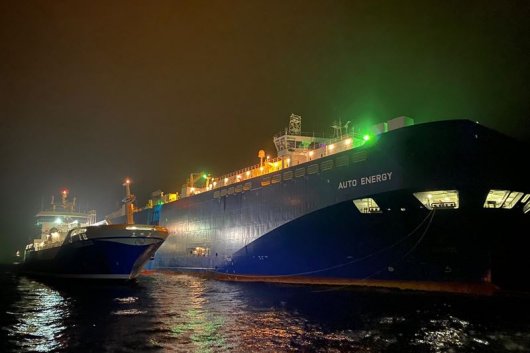Gasum performs first LNG-LBG ship-to-ship bunkering to cargo vessel
UECC car carrier receives blend of LNG and 10% renewable LBG.
Marine fuel supplier Gasum has performed what it claims to be the first ship-to-ship bunker delivery of a blend of liquefied natural gas (LNG) and liquefied biogas (LBG) to a cargo vessel.
The milestone LNG-LBG delivery, which took place on December 16, was conducted by Gasum's LNG bunker vessel Coralius at anchorage outside the Swedish port of Gothenburg.
Receiving the fuel was the M/V Auto Energy - a dual fuel LNG pure car, truck carrier (PCTC) operated by United European Car Carriers (UECC).
A blend consisting of LNG and 10 percent renewable LBG was supplied to the cargo ship, which according to Gasum became the first vessel of its kind to bunker renewable fuel at anchorage ship-to-ship.
Commenting on the news, UECC's CEO Glenn Edvardsen remarked: "With this delivery, UECC further positions itself in the front of the market by demonstrating a bold commitment to the increased uptake of renewable fuels.
"We have made a significant investment in a pioneering solution that recognises our customers' desire for a sustainable logistics partner. We choose this path because we believe in taking the initiative and signify to the market that it's possible to transport your cargo carbon neutrally with UECC."
Jacob Granqvist, Maritime Sales Director at Gasum, commented: "We are very excited to see our first ship-to-ship bunkering with the blend of LNG and LBG go smoothly. We can now perform ship-to-ship bunkering with different blends of LNG and LBG which will open new possibilities for our clients as well as for us to go forward in decarbonizing maritime transport."
UECC - a joint venture between Nippon Yusen Kabushiki Kaisha (NYK Line) and Wallenius Lines - has been actively exploring alternative fuel options and working towards the decarbonation of its cargo fleet for several years.
The contract to build the 181-metre-long Auto Energy and its sister ship the Auto Eco was signed back in March 2014, and when launched the two vessels became the world's first dual-fuel PCTCs and the first car carriers with a main engine able to run on LNG.
The milestone LNG-LBG delivery, which took place on December 16, was conducted by Gasum's LNG bunker vessel Coralius at anchorage outside the Swedish port of Gothenburg.
Receiving the fuel was the M/V Auto Energy - a dual fuel LNG pure car, truck carrier (PCTC) operated by United European Car Carriers (UECC).
A blend consisting of LNG and 10 percent renewable LBG was supplied to the cargo ship, which according to Gasum became the first vessel of its kind to bunker renewable fuel at anchorage ship-to-ship.
Commenting on the news, UECC's CEO Glenn Edvardsen remarked: "With this delivery, UECC further positions itself in the front of the market by demonstrating a bold commitment to the increased uptake of renewable fuels.
"We have made a significant investment in a pioneering solution that recognises our customers' desire for a sustainable logistics partner. We choose this path because we believe in taking the initiative and signify to the market that it's possible to transport your cargo carbon neutrally with UECC."
Jacob Granqvist, Maritime Sales Director at Gasum, commented: "We are very excited to see our first ship-to-ship bunkering with the blend of LNG and LBG go smoothly. We can now perform ship-to-ship bunkering with different blends of LNG and LBG which will open new possibilities for our clients as well as for us to go forward in decarbonizing maritime transport."
UECC - a joint venture between Nippon Yusen Kabushiki Kaisha (NYK Line) and Wallenius Lines - has been actively exploring alternative fuel options and working towards the decarbonation of its cargo fleet for several years.
The contract to build the 181-metre-long Auto Energy and its sister ship the Auto Eco was signed back in March 2014, and when launched the two vessels became the world's first dual-fuel PCTCs and the first car carriers with a main engine able to run on LNG.

|
Swedish biomethane bunkered in Gothenburg
Test delivery performed by St1 and St1 Biokraft, who aim to become large-scale suppliers. |
|
|
|
||

|
Cockett to be closed down after 45 years
End of an era as shareholders make decision based on 'non-core nature' of Cockett's business. |
|
|
|
||

|
Petrobras confirms prompt availability of VLS B24 at Rio Grande
Lead time for barge deliveries currently five days. |
|
|
|
||

|
IMO approves pricing mechanism based on GHG intensity thresholds
Charges to be levied on ships that do not meet yearly GHG fuel intensity reduction targets. |
|
|
|
||

|
VARO Energy expands renewable portfolio with Preem acquisition
All-cash transaction expected to complete in the latter half of 2025. |
|
|
|
||

|
NYK trials biofuel in milestone coal carrier test
Vessel is used to test biofuel for domestic utility company. |
|
|
|
||

|
H-Line Shipping orders LNG bunkering vessel
Vessel with 18,000-cbm capacity to run on both LNG and MDO. |
|
|
|
||

|
How to engineer and manage green shipping fuels | Stanley George, VPS
Effective management strategies and insights for evolving fuel use. |
|
|
|
||

|
Swedish government bans scrubber wastewater discharges
Discharges from open-loop scrubbers to be prohibited in Swedish waters from July 2025. |
|
|
|
||

|
MAN Energy Solutions achieves 100% load milestone for ammonia engine
Latest tests validate fuel injection system throughout the entire load curve. |
|
|
|
||
Related Links
- · Pavilion and Gasum to jointly develop LNG bunker network [Insights]
- · Gasum performs first truck-to-ship LNG delivery in Germany [Insights]
- · Nauticor performs first LNG ship-to-ship delivery to a product tanker in Germany [Insights]
- · Contract to build two PCTCs with LNG fuel propulsion system [Insights]
- · Sweden [Directory]
- · Gothenburg [Directory]

